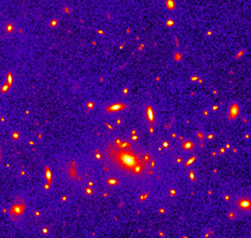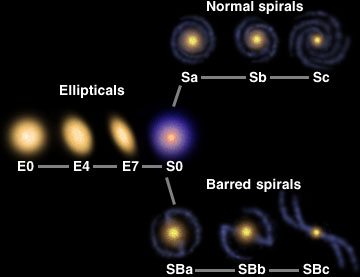Click on image for full size
HST: Megan Donahue (STSCI); ground: Isabella Gioia (University of Hawaii), and NASA.
Related links:
Hot, Heavyweight Cluster Found!
News story originally written on August 20, 1998
Megan Donahue, an astronomer with the Space Telescope Science Institute, has discovered one of the heaviest and hottest galaxy clusters. Cluster MS1054-0321, located 8 billion light-years from Earth, contains thousands of galaxies and many trillions of stars! The temperature of its intergalactic gas (the material between galaxies) is approximately 300 million degrees Fahrenheit. Imagine finding this during your normal work day!What Donahue and colleagues have found is that this cluster is surprisingly massive; it is a heavyweight of clusters. Now remember, by looking so far away, these astronomers are seeing this cluster as it was when the universe was half the age it is now.
In this traditional view of the universe, either space holds just enough matter to be able to expand forever or the universe is a dense universe and it will collapse under its own weight into a reverse Big Bang. According to dense universe theories, massive clusters such as MS1054-0321 should not have had time to form this way yet (ie, this cluster should not be so massive according to the dense universe theory). So the conclusion that these astronomers are making is that the universe is not a dense universe, or it is not dense enough to stop its own expansion. This discovery becomes another piece of evidence supporting the eternal universe.















